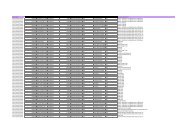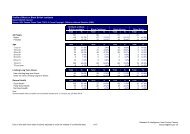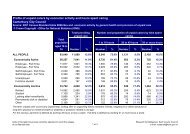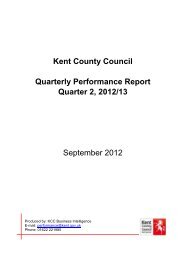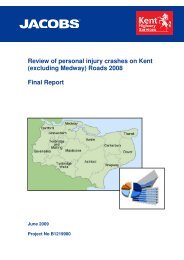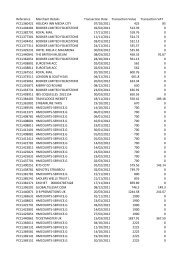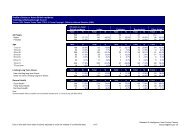Kent Design - Technical Appendix - Kent County Council
Kent Design - Technical Appendix - Kent County Council
Kent Design - Technical Appendix - Kent County Council
Create successful ePaper yourself
Turn your PDF publications into a flip-book with our unique Google optimized e-Paper software.
design<br />
2.2.2.3 CROSS-SECTIONAL GRADIENT<br />
The carriageway cross-section shall have a profile which is either<br />
cross-fall or cambered, generally at a gradient of 2.5% (1 in 40).<br />
Changes in cross-sectional gradient from cross-fall to cambered<br />
should be avoided where the longitudinal gradient is flat.<br />
2.2.2.4 VERTICAL CURVES<br />
Vertical curves shall be provided at all changes of longitudinal gradient<br />
as indicated in fig 8.<br />
FIGURE 8 - VERTICAL CURVES<br />
To ensure reasonable standards of comfort and appearance and to<br />
secure appropriate visibility at summits, vertical curves should be<br />
provided using the following criteria.<br />
The length of curves shall be derived using the formula: L=KA; where<br />
L is the curve length in metres, A is the algebraic difference in gradient<br />
(expressed as a percentage) and K has a value as indicated in table 3.<br />
(roundabouts), depending on the traffic flow and turning<br />
characteristics. Junctions involving industrial and commercial roads<br />
shall be designed in accordance with section 2.3.<br />
Junctions involving all other road types shall be simple ‘T’ type<br />
arrangements. Staggered junctions shall be designed in accordance<br />
with the spacing criteria detailed in table 5. Where traffic flows are<br />
very low, for example within minor access ways, consideration may<br />
be given to crossroad type arrangements.<br />
Where non-priority roads, including all connecting roads, serve more<br />
than 100 dwellings the junction with the priority road shall be at an angle<br />
of 90º and shall be straight for a length of at least twice the kerb radius.<br />
Non-priority roads, including all connecting roads, serving less than 100<br />
dwellings can join priority roads at angles between 80º and 100º.<br />
Some junctions involving minor roads, such as shared surface<br />
accessways, may require specific entry treatment arrangements in<br />
accordance with section 3.5.<br />
It is recommended that early discussion regarding the junction type,<br />
design and location should be held with the Engineer.<br />
2.2.3.3 RADII<br />
Junction radii shall be provided in accordance with table 5. All<br />
dimensions shown in table 5 apply to the priority road.<br />
At junctions where the corner radii is less than 6m the footway shall<br />
be strengthened in accordance with tables 19 and 21.<br />
TABLE 3: K VALUES<br />
Vehicle or Pedestrian and Target Minimum K value<br />
Cycle Environment Type Speed for stopping<br />
and adequate comfort<br />
District Distributor Road 30 11<br />
Local Distributor Road<br />
Industrial local Distributor Road<br />
Industrial Access Road<br />
Major Access Road 25 7<br />
Minor Access Road/Way 20 5<br />
Shared Surface Areas 15 3<br />
Homezones 10 1<br />
2.2.3.4 VISIBILITY<br />
To enable drivers emerging from the non-priority road to see and<br />
been seen by drivers proceeding along the priority road<br />
unobstructed visibility is required within the shaded area shown in fig<br />
9, with inter-visibility being provided between heights of 0.6 and 2m.<br />
Sags and summits may affect visibility requirements.<br />
2.2.3 JUNCTIONS<br />
2.2.3.1 GENERAL<br />
Junctions are generally required at the intersection points where<br />
roads meet each other. The majority of junction arrangements take<br />
the form of some type of priority junction, (either ‘T’ types,<br />
staggered types or crossroads) which is normally appropriate where<br />
traffic flows, particularly to and from minor roads, are relatively light.<br />
Where flows are heavier or layouts are complex, other types of<br />
layout or control are required to reduce the accident risks and to<br />
balance or improve capacity.<br />
Where a residential road joins a distributor road, a 5.5m width shall be<br />
maintained for 20m from the junction and footways provided on both<br />
sides of the non-priority road. No other road junctions shall be<br />
permitted within this 20m distance including all driveways and accesses.<br />
Junction arrangements involving alterations to the existing highway<br />
will require the developer to enter into a separate agreement under<br />
the provisions of Section 278 of the Highways Act 1980.<br />
2.2.3.2 TYPES<br />
Junctions involving district distributor or residential local distributor<br />
roads shall be designed in accordance with the <strong>Design</strong> Manual for<br />
Roads and Bridges, published by the Department of<br />
Transport, Volume 6 Section 2, TD42/95 or TD16/93<br />
28<br />
<strong>Kent</strong><br />
<strong>Design</strong><br />
FIGURE 9 - VISIBILITY<br />
All junctions will require adequate visibility in accordance with table<br />
5. Street lighting columns, sign posts and some trees can be located<br />
within the visibility splays, but larger obstructions shall be avoided as<br />
they could reduce safety levels.<br />
Visibility splays at junctions shall be contained within the adoptable<br />
highway. It is generally desirable for a footway to be set back behind<br />
the visibility splay.<br />
2.2.3.5 GRADIENTS<br />
Gradients should not exceed 5% when rising, or 4% when falling<br />
towards the priority road for a distance of twice the junction radii<br />
measured from the channel line of the priority road.<br />
2.2.3.6 RIGHT TURN LANE FACILITIES<br />
Some junctions will require the right turning movements of vehicles<br />
from the priority road to be controlled by various methods, which<br />
can include amongst other things ghost islands, roundabouts and<br />
signal controls.<br />
RTL facilities for local distributors and industrial roads shall be in<br />
accordance with section 2.3.





